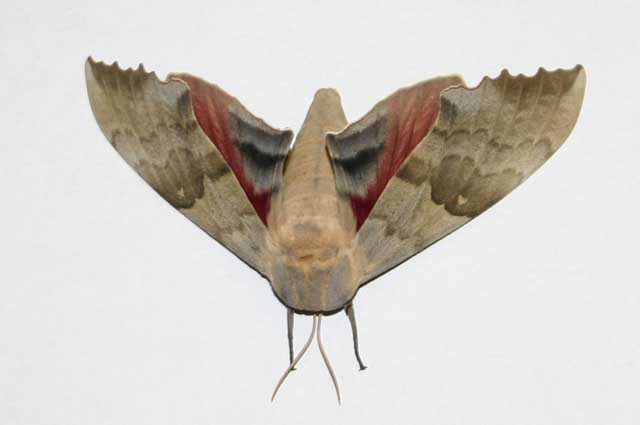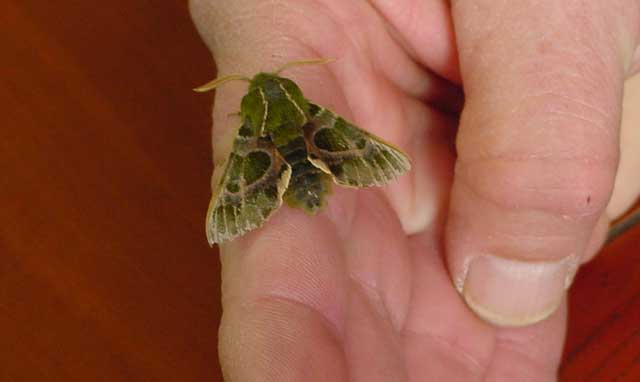Sphinginae subfamily
Sphingini tribe:
 |
This species is present (reported) and larvae feed on tomatoes and go
by the common name of "Tomato Hornworms". |
 |
Although not reported from Umatilla, I suspect it is present.
I only see them occasionally on P.E.I. despite visiting lights frequently. |
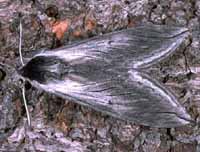 | The upperside of the forewing is dark grey to black with a
paler costa and pale area from the base to the wing's centre.
Prefered habitats include montane woodlands and mixed chaparral-type
vegetation. |
 |
Sphinx vashti
USGS, the Snowberry Sphinx
The upperside of the forewing has a narrow black subterminal line
bordered by a white inverted V-shaped line on the outside, and a
black line running inwards from the apex of the wing.
It is most often found in montane woodlands and along streamcourses. |
Smerinthini Tribe:
 |
Pachysphinx modesta
USGS,
the Modest Sphinx or Poplar Sphinx,
This large poplar/willow feeder is reported in Umatilla.
They are a heavy bodied species. Forewing lines are less distinct than in more
yellowish P. occidentalis.
|
 |
Look for a distinct am line.
This one is quite similar to Pachysphinx modesta, with modesta being smaller and darker, and having less distinct fw lines.
There may be naturally occuring hybrids in Umatilla.
|
Pachysphinx occidentalis, Hermiston, July 22, 2008, Don Gillis
 |
The grey-blue eyespot of the hindwing gives this species its name.
Larvae feed on birches, willows, cherries and oaks.
The outer edge of the forewings is quite scalloped.
|
 |
Paonias myops USGS,
the Small-eyed Sphinx
This small species is probably widespread and common. This species ranges across North America.
The hindwings have a small blue eyespot ringed with black on a yellow background.
|
 |
If you have willows and poplars nearby, you've probably got populations of
the Cerisyi's Sphinx. The hindwings are quite striking.
|
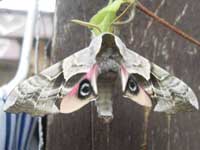 | Larvae feed on poplars, aspen and willows.
Note different shape of double arced forewing pm line compared to the straighter pm line of cerisyi, directly above.
S. ophthalmica has smoother scalloping of the fw outer margin.
|
Macroglossinae subfamily
Dilophonotini tribe
 |
Hemaris diffinis USGS, the Snowberry Clearwing or Bumblebee Moth
This species is reported from Umatilla, and this day flying moth
is widely distributed in Oregon. |
Macroglossini tribe
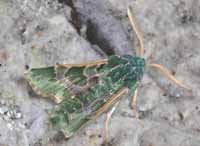 |
Arctonotus lucidus USGS/DG, the Pacific Green
Sphinx Moth or Bear SphinxThis species
is recorded in Umatilla.
It tends to be an early spring flier, on the wing in the early
evening. It comes to lights at night.
|
Arctonotus lucidus, Don Gillis
 |
Hyles gallii WO,
the Bedstraw Hawk Moth or Gallium Sphinx
This species is not officially reported from Umatilla County, but if
you have Gallium or Epilobium, you might have
populations of this species, but it is doubtful.
|
 |
Hyles lineata SW, the White-lined Sphinx
It can be seen flying during the day,
into the evening and also at night.
The highly variable larvae are often found in people's gardens.
|
Stewart Wechsler, Blue Mountain area.
Stewart writes, "I most often remember seeing the moths around
Clarkia pulchella "Elkhorn Clarkia" / "Pink Fairies"- (less) and
later Epilobium brachycarpum (aka E. paniculatum) - "Tall Annual
Willowherb"- more (when few other plants were fresh and blooming)".
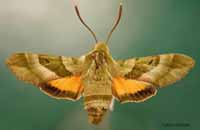 |
This species is reported from Umatilla County, this day flier,
April-June, prefering oak woodland and pine-oak woodland in foothills,
is probably present. Moths nectar at a variety of flowers in the afternoon.
|
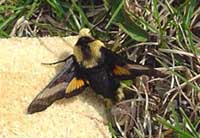 |
This day flier is not officially reported from Umatilla, but it has
been found to the north, east, south and west in meadows near coniferous forests. |
|
|
